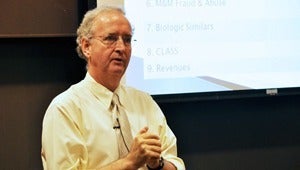July 27, 2011 — Cites Political Process as Biggest Hurdle to Full Rollout
HSPH Prof. John McDonough launched the School’s 2011 Hot Topics speaker series with an overview of the Affordable Care Act of 2010 (ACA) and a progress report on the implementation of its many parts. The highly contentious and politically polarizing ACA is not good enough, but it was the best health care law achievable in the current environment, he told the HSPH audience in FXB G-11 on July 12.
McDonough, director of the Center for Public Health Leadership at HSPH and a former member of the Massachusetts House of Representatives, served as an advisor to the U.S. Senate during the national health reform debate. He also played a key role in passage and implementation of the 2006 Massachusetts health reform law as the executive director of the consumer advocacy organization Health Care For All.
McDonough said that he was “mightily impressed” with the work by Secretary of Health and Human Services Kathleen Sebelius and the rest of the Obama administration during the implementation of the initial reforms, which include allowing parents to keep children on their coverage until age 26, phasing out lifetime and annual benefit caps, and closing the Medicare prescription drug coverage gap known as the doughnut hole, and many other reforms.
The most significant changes are set to take place in 2014. At that time, nearly everyone will be required to have health insurance or pay a fine (a provision currently facing court challenges). Medicaid will expand coverage to include nearly all low-income Americans. Those earning between 138-400% of the national poverty line will receive subsidies to buy health insurance through new state-run health insurance exchanges.
Expanding access and affordability of health coverage is addressed in just two of the ACA’s titles. In seven remaining titles and two additions, the sprawling bill touches upon virtually every aspect of the U.S. health care system, from reforming the way providers are paid through Medicare to increasing preventive services, boosting the health workforce, and combating fraud and abuse.
If the law is enacted as written, it is projected to save about $70 billion over 10 years and one to two trillion in the following 10 years, said McDonough, though he added that enacting the law completely as is “will never happen.” Areas of potential savings include an anticipated reduction in uncompensated care use by newly insured patients and new revenues, including higher Social Security taxes on upper income individuals and additional taxes on the pharmaceutical, medical device, and insurance industries.
The biggest challenge to a full rollout of the law is the political process, McDonough said.
McDonough’s book, Inside National Health Reform (California/Milbank Books on Health and the Public), is now available.
— Amy Roeder
Photo: Aubrey LaMedica
Learn more
The Impact of the 2010 Elections on U.S. Healthcare Reform (The Forum at Harvard School of Public Health)
Health Care for (Almost) Everyone (Harvard Public Health Review)
More Hot Topics
Location, Location, Location: Where You Live Can Affect Your Health — Featuring Francine Laden, Mark and Catherine Winkler associate professor of environmental epidemiology
Take It to Heart: Positive Emotions May Be Good for Health — Featuring Laura Kubzansky, associate professor of society, human development, and health
Protecting Children From Adversity Key to Healthy Development — Featuring Jack P. Shonkoff, Julius B. Richmond FAMRI professor of child health and development and director of the Center on the Developing Child at Harvard University
Technology Boosts Humanitarian Efforts — Featuring Michael VanRooyen, director of the Harvard Humanitarian Initiative, associate professor in HSPH’s Department of Global Health and Population, and associate professor of medicine at Harvard Medical School
